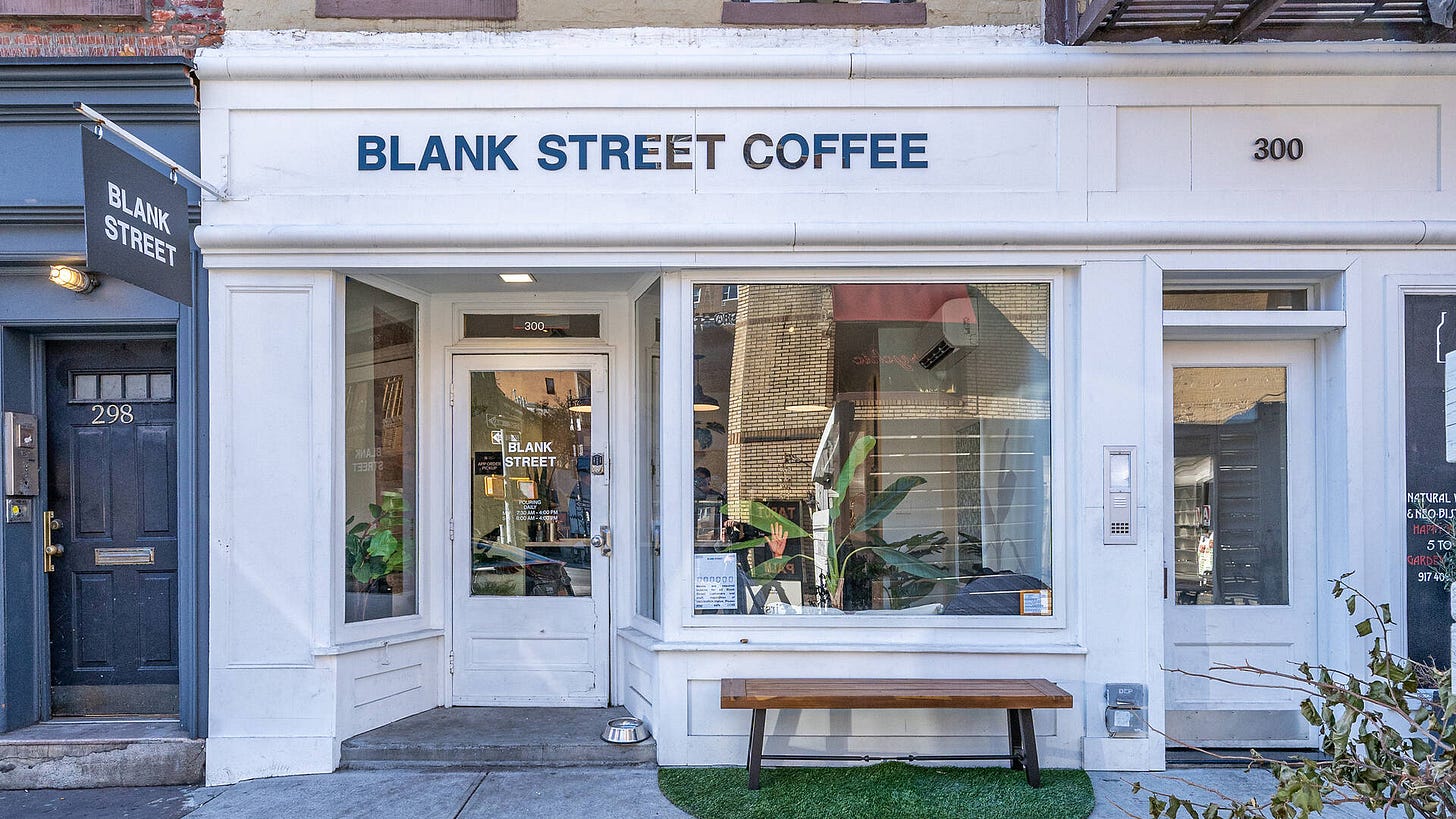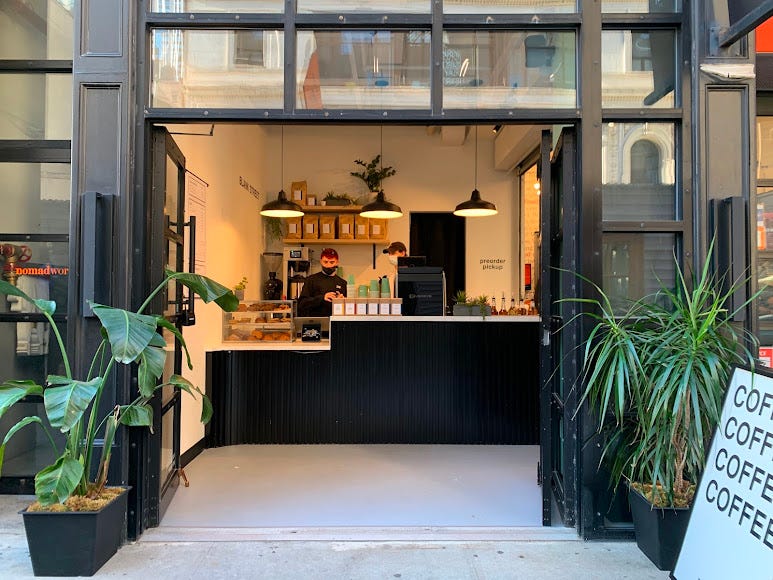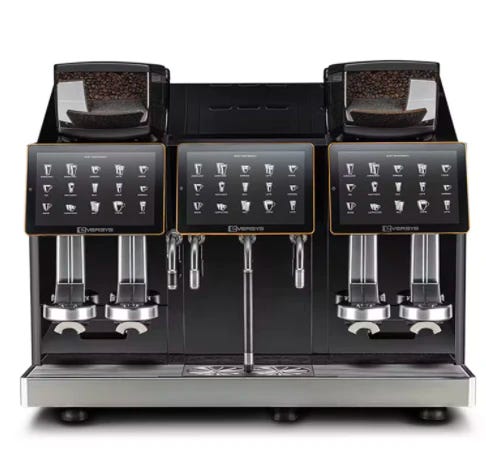I was not a good barista.
I got my first job at 16 years old at a Starbucks. While I was great with customers and raking in tips, I was awful at making drinks. I’ll never forget when a woman asked for a chai – a really simple drink – and I made her… something not that. Eventually, the manager kept me on the register. I don’t blame her. That job not only gave me physical/emotional burns but also gave me a lifetime interest in coffee shops.
Previously, we discussed how Erewhon, the country’s most expensive grocery store, is sneakily built as a third place. This time around, I wanted to explore its mirror: how a business traditionally thought of as a third place is finding success by not being one.
Blank Street is a micro-coffee shop chain that, as of writing, has 40 locations. They are primarily in New York City but also reside in D.C., Boston, and London. I first heard about Blank Street back in 2020, before they opened their first location. During my time at MetaProp, we were sent their pitch deck. It is astounding to see how quickly that pitch deck metastasized into a coffee chain going after Starbucks’ breakfast. In March, they did the seemingly impossible. They raised ~$27M – for a real estate business – at a time when the venture markets were as cold as ice.
This was a narrative outlier. I had to understand what they were doing differently. As I peeled back the business, I learned that Blank Street was able to gain the confidence of top-tier investors for two reasons:
Profitability: “All of Blank Street’s New York locations have been profitable on a per-unit basis within a month of opening” (Fast Company)
Retention: “The company’s ability to retain customers is what attracted investors to the new round” (Fast Company)
“Profitability” and “retention” are not words often said about most venture-backed real estate startups. This is especially true for a company that grew to four markets and 40 locations in less than three years. As I pierced Blank Street’s playbook, it is clear that Blank Street is shedding industry norms to build a new type of coffee chain with a focus on volume over vibes. Let’s study it.
But first, a detour to Mama Bucks.
Starbucks Moves Towards the Bucks
After the first place (home) and second (work), the third place as coined by sociologist Ray Oldenburg “is a generic, neutral ground where people can gather without any special purpose in mind, to relax, talk, and have a good time. It serves as a home away from home and a club without dues". Common examples are bars, parks, libraries, community centers, and coffee shops.
The first coffee chain to do this at scale was Starbucks. They write, “In 1987, Starbucks expanded into a European café model with added seating…Customers lingered in stores, even if they had no one to meet for the simple experience of being met with a friendly face and taking a moment to pause in the day”. Starbucks became the place, across the country, where people went between meetings or after school. It's where they went on dates or to co-work. You get to know your baristas and the baristas get to know you. It’s ~cozy~.
But times are a-changing. Starbucks stores look and feel much different today than they did a decade ago. Amongst aesthetic changes, you’ll notice less, and less comfortable, seating. This is deliberate as Starbucks optimizes their stores for mobile orders over coziness.
This change could be seen as a COVID reaction but this alteration would likely have happened regardless. Before COVID, 80% of Starbucks orders were to-go. In a 2020 press release, they explained store changes were “...to meet the already evolving customer needs of convenience, connection, and personalization offered through a digital experience". Starbucks is optimizing the company for its high volume of mobile orders over the more service-intensive in-store experience they were first known for.
They are forgoing their position as a third place to local coffee shops and smaller chains. While this seems like a corporation “selling out”, the coffee empire is merely following where we, the consumers, are taking them. They are doing what makes the most cents.
As Starbucks heaves and hoes to reinvent itself, Blank Street is taking full advantage of its small store size and automation to compete against them in key markets. Whether by chance or by design, Blank Street is building the coffee chain that Starbucks wants to become itself. Let’s see how.
Blank Street’s Growth Playbook
Blank Street was founded in 2020 by Vinay Menda and Issam Freiha. They previously co-founded a VC firm called Reshape whose entire premise was to back companies innovating the built environment. They invested in startups like Sonder, Sweetgreen, and Postmates. With this access, they were able to study a myriad of tech-enabled real estate companies and learn lessons from each. These learnings resulted in an asset-light growth playbook that other modern real estate concepts can learn from. I have identified seven levers that Blank Street pushed and pulled to physically expand quickly, achieve 4-wall profitability, and retain customers:
Store Size
Store Design
Automation
Labor
Pricing
Vertically Integrating
Retention Program
Store Size
The first key to Blank Street’s strategy is its small footprint. Blank Street always planned to be miniature. Their initial pitch was to solely operate coffee carts the same size as your usual halal cart. They parlayed from parks and office courtyards into storefronts that are, on average, 350 square feet. For comparison, the average Starbucks is 1500-2000 square feet. By maintaining a small floor plate, Blank Street can:
Work well in a variety of square footage, which gives the company more choices on where to set up shop. They can go where others can’t. More options mean that their serviceable addressable market is essentially wherever there is a high concentration of coffee drinkers.
Aren’t limited by the need for a kitchen line or bathroom hookups. This removes a lot of red tape that slows down restaurant openings AND gives Blank Street more potential real estate to expand into.
Keep leasing costs low, which pads its margins.
In addition, this militant focus on keeping locations small gives it options for the future. If there was a reason to, they could take on larger floor plates.
Alternatively, due to their comfort in tight spaces, they will succeed in office/hotel lobbies, airports, and Targets. Where there is demand for coffee, Blank Street could be there.
Store Design
There isn’t much you can do with 350 square feet and that’s intentional. They have built their stores to sell high volumes of coffee and not much else. It has minimal, if not any, seating. The benefits of this are:
Allows employees to focus on serving and connecting with customers and less on maintaining the facility
Lowers the need for staff overall, keeping labor costs low and therefore, padding its margins once again. Most locations have only two employees.
Automation
Blank Street built its business around automation. Beyond the well-built and easy-to-use mobile app, the key is Eversys Shotmaster Pro Superautomatic Espresso Machines. These bad boys go for $50K a pop and can make 700 espressos per hour, eight at a time. AND they can grind beans and steam milk. In Eversys’ own words, this machine is “ideal for high volume environments where espresso shots with ultimate in-cup experience matters most”. This allows Blank Street employees to be more present with customers while also being able to handle a high volume of them. While this machine is a significant upfront cost, it is the critical factor that allows Blank Street to succeed in tight spaces and be the most convenient coffee shop on the block.
Labor
Given how focused Blank Street is on profitability, you would think that they would stick to paying their employees minimum wage ($15 in NYC). Instead, their starting pay for baristas is $23/hour + tips. This helps with employee retention and overall well-being. In a coffee shop environment, retained and happy employees are instrumental to retaining customers. That genuine connection between an engaged barista and a customer makes all the difference when we are deciding which coffee shop to get our fix from.
Pricing
Blank Street has always positioned its coffee as high quality, yet more affordable than its peers. They strike a middle between Dunkin and Starbucks. For example, a 16oz iced latte may cost $3.75 at Dunkin’, $5.50 at Starbucks, and $4.25 at Blank Street. They can offer this price by the efficiencies achieved throughout the rest of the business.
This price differential also may steal customers away from their peers who may reconsider paying a higher price for a similar-enough product. This price positioning is another driver that encourages retention and volume.
Vertically Integrating
Blank Street is expanding its margins by vertically integrating throughout its supply chain. In 2022, Blank Street moved away from its partnership with Parlor Coffee and started making its own blend. With its heft at 40 locations today, it can have serious and long-term conversations with partners to do so. Issam says, “We’re one of the largest specialty coffee brands in the market… we can start looking at five-year horizons versus three-month horizons.” Another major move they are considering is to add its own breakfast menu. Up until this point, they were partnering with local bakeries. Having both in-house coffee and food allow for supply and cost stability, allowing Blank Street to provide more attractive prices to customers and therefore, retain customers.
Retention Program
And we arrive at a potential Trojan horse: the “Regulars Program”. This is a weekly subscription that costs $12 + tax. Its benefits are:
Cold brew, hot brew, or tea is free every 2 hours
All other drinks like lattes are $1
20% off coffee bags and merchandise
The benefits of such a program are tri-fold:
Free Cash Flow
Going back to Mama Starbucks for a moment. Starbucks does everything it can to encourage cash uploads in its app for future visits. Neil Patel of the Motley Fool explains why, “Starbucks is essentially gaining access to an interest-free line of credit… it can reinvest directly back into the business on expansion opportunities. The company's free cash flow is also enhanced, as this phenomenon decreases working capital needs” (Inc). In 2022, the yet unused balances across Starbucks mobile and gift card balances were $1.6B. Net unused balances at the end of the year gave Starbucks $196M in additional revenue FOR FREE.
Similarly, Blank Street moving to a subscription model allows a portion of the company’s revenue to be predictable and locked in. You are giving Blank Street a loan and they are paying you back in caffeine.
Retention
Another benefit of this subscription is to further encourage retention. Why go to another coffee shop when you have a free drink waiting for you at Blank Street?
Now that their coffee is “paid for”, Regulars may be more inclined to bring co-workers or friends to Blank Street vs. the shop across the street. This gives Blank Street yet another customer.
Have Something Else
This subscription model may also encourage customers to buy add-ons to their beverages or purchase food goods now that the coffee part is taken care of.
It’s currently in beta and I haven’t been able to try it myself. Blank Street, if you’re reading this, hook a brotha up.
Where are the copycats?
Putting it all together, Blank Street has been able to grow quickly while maintaining profitability by keeping costs low, pushing sales volume and encouraging retention.
Given Blank Street’s success, it is head-scratching that we haven’t seen more micro-cafes pop up. It’s not a dog fight for real estate like it was with the 15-minute delivery companies or co-working players. This makes me believe that replicating Blank Street’s playbook is harder than it seems.
Blank Street doesn’t seem stressed about competitors either. They said they are “planning to slow the pace of openings” and that the new $20M cash infusion was to “increase the in-store offerings at their current cafes” (Fast Company). This reflects the macro change we have seen across the startup ecosystem from “grow as fast as possible, at all costs” to “profitability”. From what I can tell, they have been set up for growth and profitability since day one.
I can understand why investors are continuing to support Blank Street. It is built for standardization, retention, and volume. Every decision it has made pushes one of these forward. To do this, they had to first subvert the standard set that all coffee shops should be a place for us to mingle and relax. Coffee shops will always be a third place for us. It’s in our bones as human beings. But don’t try to make Blank Street a home. This coffee chain is for the streets.
Thanks for reading,
Safi
What’s next?
Like what you read? Please like and leave a comment. It really helps!
Consider subscribing or sharing this with someone that is into coffee shops
If you are an American ex-pat or digital nomad, I want to hear from you for a future piece. Drop me a DM on Twitter!
















Fascinating! We stopped into a Blank Street across from Tompkins Park (I think it's the one you pictured). It was kinda jarring. The prices seemed too good to be true. The espresso machine is kinda like the Death Star. The employees were super nice. It was fast, line moving at lightning speed. I can see how the subscription would work wonders. The fact that its also small and pays employees well will, I think, play well with folks disgruntled with SBUX.